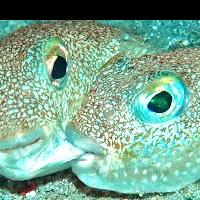Top 10 Amazing NEW SPECIES
These are the ten most incredible new species of plants and animals discovered in the last year, as chosen by New York's College of Environmental Sciences and Forestry.
This feathered dinosaur bridged the evolutionary gap between older ancestors like the T-Rex, and modern day birds.
Anzu wylei is similar to a velociraptor in size, but, like a bird, it made nests and sat on its eggs until they hatched, and also had hollow bones and a parrot-like short beak. This coral-like tuber plant -- scientifically named Balanophora coralliformis -- is a parasite (meaning it eats other plants instead of getting its energy from photosynthesis).
It's found in the Mt. Mingan region of the Philippines. Cebrennus rechenbergi is a spider that uses an energy-conserving cartwheel technique to propel itself toward threats.
In the deserts of Morocco, where it lives, a lack of places to hide and high temperatures makes running away a bad option. This tiny sea creature looks like a plant, but the Dendrogramma enigmatica is actually a multicellular animal with a mouth at the end of its “stem.” It seems to be related to jellyfish or anemones, but it's also evolutionarily different enough that it could be a whole new phylum.
What makes the Deuteragenia ossarium special is brilliant engineering. It lays its eggs one each in separate cells formed in hollow stems. Not only does it kill a spider and drop it in each cell as nourishment for her young, but she completely walls off the end of the stem with the bodies of dead ants, creating a chemical barrier that hides the fact that it's the front door to her precious nest. This little frog in Indonesia is one of a kind.
Of the more than 6,400 species of frogs on our planet, the Limnonectes larvaepartus is the only one that gives birth to live tadpoles. Phryganistria tamdaoensis gets its name from the beautiful Tam Dao National Park in northwestern Vietnam, where this giant stick insect had gone undiscovered until now.
This sheds light on just how we've left to go. Of the 12 million total estimated species that exist in the world, we have discovered and named just 2 million, or 16%. This new species of sea slug is a beauty of the deep living in the waters off the coast of Japan.
The Phyllodesmium acanthorhinum appears to glow blue, red and gold when photographed. With its rose colored spikes, the Tillandsia religiosa has long been used to decorate elaborate nativity scenes in remote parts of Mexico, but scientifically it had gone undiscovered, until now.
The bromeliad grows on cliffs at altitudes between 6,000 and 7,000 feet.
For 20 years the cause of these geometric designs on the seafloor was a mystery, until their designer was discovered, a subspecies of Pufferfish called Torquigener albomaculosus. What looks like an underwater crop circle is actually a nest that minimizes ocean current to protect eggs buried in the center.
Thanks for watching.
Leave a comment below about which new species is your favorite. And if you enjoyed this video, hit that like button to help it spread. You can watch more TDC by clicking the video on the left to see how climate change is causing unpredictable changes in the habitats of animals around the world; or the video on the right to see a possible plan for wind power to stop deadly hurricanes, while powering the entire United States. And you can take us up on our offer for a free audiobook, like Kristin Ohlson's, The Soil Will Save Us: How Scientists, Farmers, and Ranchers Are Tending the Soil to Reverse Global Warming..or any other book. It's linked below. For my co-producer, Brendan Plank, here at The Daily Conversation, I'm Bryce Plank. We'll leave you with the wise words of the naturalist and proud Californian John Muir who said, “When we try to pick out anything by itself, we find it hitched to everything else in the universe.”

